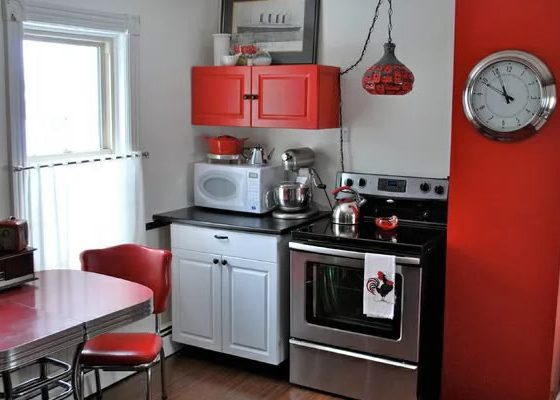As you browse in your local antique store or peruse items in an online auction, you might see vintage enamelware pitchers. These beautiful and practical items are as useful today as they were a century ago.
What Is Enamelware?
Enamelware was extremely popular in the 19th century due to its affordability, durability, and beauty. To make enamelware, manufacturers create an enamel mixture out of superheated quartz, feldspar, metal oxides, water, clay, and other materials. This mixture was then cooled and compressed to eliminate excess water. The resulting product was similar to glass and was ground up and fused to a base material like tin, cast iron, or aluminum. Also known as “graniteware” or “agateware,” vintage enamelware often features beautiful stone-like swirls and speckles.
Styles of Vintage and Antique Enamelware Pitchers
Enamelware pitchers became a staple in many family homes, and they came in a variety of sizes and styles. As you browse in antique stores and online, you may encounter the following exciting variations.
White Enamel Pitchers
The classic vintage white enamel pitcher is easy to find in many antique shops, and its neutral color goes beautifully in any room. You’ll find white enamel gallon pitchers designed to pour water, as well as tiny pitchers made for cream and other condiments. Many feature black details along the rim or handle.
Blue Enamel Pitchers
Another traditional color for enamel pitchers was blue. The most common shade is a deep cobalt color, but blue enamel pitchers also came in pale shades like cornflower or baby blue. They can be a lovely pop of color in a kitchen or dining room. Like their white enamel cousins, blue pitchers also come in a range of sizes.
Other Colors of Enamelware Pitchers
Enamelware pitchers didn’t just come in blue and white. Although these are easily the two most popular colors, you’ll see these pitchers in shades like pale yellow, brown, green, orange, red, and other colors. If you collect vintage enamelware, it can be fun to find pitchers in a wide range of colors.
Splatterware and Graniteware Enamel Pitchers
Not all enamelware pitchers are solid colored. The enamel process lent itself to a variety of different patterns. Splatterware featured large splatters of color on a solid white background. Graniteware had subtler patterns with specks of white on a colored background or specks of color on white. You’ll also see swirled patterns and other pretty designs.
Enamel Pitcher and Bowl Sets
Many large enamel pitchers are also part of pitcher and bowl sets, often used for washing up. Before the age of indoor plumbing, wash sets were a staple in many bedrooms. Enamelware sets were an affordable alternative to porcelain and china, and you can still find these sets in antique stores today.
Where to Find Vintage Enamelware Pitchers
Because enamelware is so durable, it’s not difficult to find a wide variety of vintage and antique enamelware pitchers. Here are a few of the best places to shop for enamelware kitchen items, including pitchers:
- Look in your own kitchen cabinets, and check with family members. Enamelware items are often passed down through the generations, since they are so durable.
- Scan the wares at flea markets and garage sales. It may take some searching to find just the right enamelware pitcher in these settings, but you’ll get a great deal.
- Browse the selection at your local antique shops. Remember that antique sellers will often negotiate on the price of an item, and enamelware pitchers are no exception.
- Keep an eye on online auction sites like eBay. This is a great way to find affordable enamelware pitchers.
- Check out online antique malls like Ruby Lane. You might be surprised at what you can find on these sites.
Uses for Enamelware Pitchers
Once you find an enamelware pitcher, you won’t believe the number of uses for this vintage kitchen item. There’s nothing like a farmhouse enamel pitcher to give your home a dose of historic charm. Here are just a few of the things you can do with enamelware pitchers:
- Use enamelware pitchers in the kitchen to serve condiments and drinks.
- Fill your pitcher with sand or stones and use it as a bookend or doorstop.
- Display cut flowers in your pitcher for a fun country look.
- If your pitcher is in less-than-perfect shape, you can use it as a planter.
Tips for Buying Enamelware
As you browse for a vintage enamelware pitcher, keep the following tips in mind:
- Carefully examine enamelware pieces for rust. If the outer layer of enamel chips away over time, the underlying surface is vulnerable to corrosion from air and water.
- Examine how the piece is constructed. If the handle is riveted (rather than soldered) to the body of the pitcher, that can indicate that the pitcher is quite old.
- Look for dents. Since many of these pitchers have been used for real kitchen tasks, you’ll see signs of wear. This can add to the charm of the piece, but if you’re looking for a pitcher in perfect condition, you’ll want to thoroughly examine it for dents.
Useful and Beautiful
Ultimately, collecting and displaying antique enamelware pitchers is an affordable and fun way to add some historic charm to your home. These vintage kitchen items are as useful as they are beautiful.













